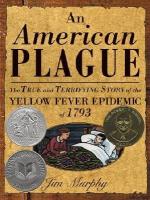|
This section contains 684 words (approx. 2 pages at 400 words per page) |

|
An American Plague: The True and Terrifying Story of the Yellow Fever Epidemic of 1793 Summary & Study Guide Description
An American Plague: The True and Terrifying Story of the Yellow Fever Epidemic of 1793 Summary & Study Guide includes comprehensive information and analysis to help you understand the book. This study guide contains the following sections:
This detailed literature summary also contains Topics for Discussion and a Free Quiz on An American Plague: The True and Terrifying Story of the Yellow Fever Epidemic of 1793 by Jim Murphy.
An American Plague - The True and Terrifying Story of the Yellow Fever Epidemic of 1793 by Jim Murphy provides a historic account of the devastation brought on by the relentless, invisible plague that literally brought Philadelphia and the federal government to its knees. The first known case of an illness that was accompanied by high fever and severe vomiting was that of a young French soldier who was staying in a boarding home. The young man, whose name is lost in history, lasted only a few days after he became ill. Not much attention was paid to his death. Only when several other boarders in the same building showed the same symptoms and eventual died themselves did anyone take much note.
However, in the intervening days when doctors began to notice a sharp increase of patients seeking treatment for fevers, aching muscles and severe vomiting, it begin to dawn on them that they may be facing an epidemic. Dr. Benjamin Rush, a respected Philadelphia physician who had dealt with yellow fever in the city in the 1760s, was the first to voice his suspicions that the rapidly spreading disease may in fact be yellow fever. Other doctors, experts and officials were reluctant to agree that the disease may have been yellow fever because the words alone could cause near panic.
The doctors, who did not know about the existence of viruses and bacteria at the time, blamed the disease on such specious theories that the smell from a cargo of coffee that had been dumped on the wharf and had become rancid was causing the sickness. It was generating such an odor that some of the doctors felt that it violated the basic belief at the time that good health depended on balance and that an outside element such as a foul odor could cause an unhealthy imbalance.
Philadelphia was the capital of the nation and President George Washington was headquartered there. Washington was preoccupied with the French government at the time. They were allies in the Revolutionary War and were asking for help from the US in carrying out their own revolution. Washington knew that the US didn't have sufficient forces to combat the European armies and issued a Proclamation of Neutrality, which angered the French as well as many Americans. When the epidemic could no longer be ignored, Washington, many of the country's leaders and Pennsylvania's governor, left town to escape the disease. The city was left in the hands of Mayor Matthew Clarkson, who felt duty-bound to stay. Washington's departure inadvertently caused the first Constitutional crises since he was disallowed from convening Congress in any location other than Philadelphia.
The mayor did everything he could to combat the plague. He had debris and dead animals cleared off the streets, made sure all dead bodies were removed from homes or off the streets and buried, issued the best advice available for avoiding the disease and called a meeting of the College of Physicians to develop a strategy to fight the menace. The doctors bickered about what caused the epidemic and how to treat it. As time went on, many doctors and health care workers along with government officials left town while the number of sick and dying only increased. The mayor called on the New African Society to supply volunteers to help the sick, particularly the poor who had no means of paying for medical attention.
By late October when the weather began to turn cold, the epidemic was on the wane. People began to return to town, more people ventured out on the streets and previously closed shops began to open. The yellow fever returned again to Philadelphia and to other large cities and occurred in many other countries around the world. The subsequent outbreaks were not as devastating due the experience gained from the 1793 plague. Many years later, it was learned that mosquitoes were the carriers of yellow fever and that tree-living monkeys in Africa and South America were the source of the virus. There is a vaccine against yellow fever but there is no cure.
Read more from the Study Guide
|
This section contains 684 words (approx. 2 pages at 400 words per page) |

|



